Human Anatomy and Physiology 2
1/33
There's no tags or description
Looks like no tags are added yet.
Name | Mastery | Learn | Test | Matching | Spaced |
|---|
No study sessions yet.
34 Terms
What is the endocrine system?
-The endocrine system communicated between cells and organs by using hormones as the messenger
What is endocrinology?
-Endocrinology is the study of hormones
What are the functions of hormones?
-Smooth muscle contraction
-Growth
-Development
-Metabolism
-Energy balance
-Temperature, H2O and electrolyte balance
-Reproduction
What is an endocrine hormones?
-Released form secretory cells into interstitial fluid and then make their way to the blood and travel to their distant targets
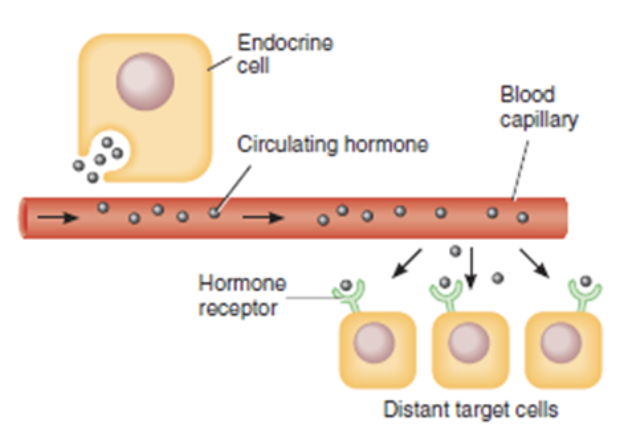
What are paracrine hormones?
-Released from secretory cells and act upon target cells that are not too distant
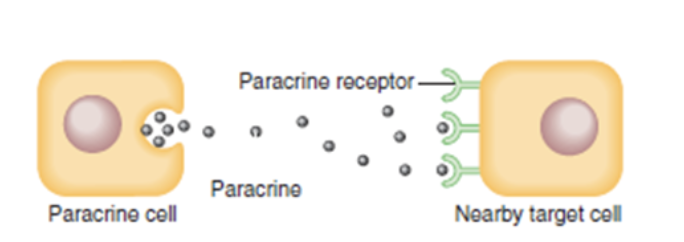
What are autocrine hormones?
-Released from secretary cells and act upon the secretory cell that release the hormones
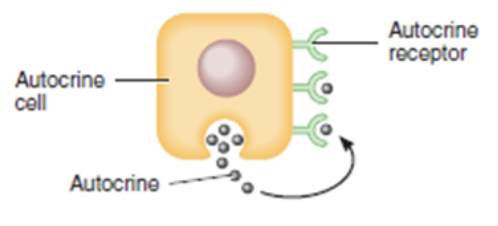
What are water soluble hormones?
-Pepetide/protein hormones that can dissolve in water, they can travel freely in blood eg: insulin
What are lipid soluble hormones?
-Steroid hormones derived from cholesterol, they travel in the blood attached to a transport protein eg: esterogen
How do hormones produce their responses?
-By acting on different cells, to produce on their responses they need to activate a protein called a receptor which can be on the surface of the target cell membrane or inside the cell
What are peptide/protein hormones?
-Act on receptors on the cell membrane, they are located on the surface of target cell, because they are activated by water soluble hormones
What is the mechanism of action for GPCR?
1.Hormone binds to receptor and activated a G protein
2.Regulates production of a second messenger
3.Regulates protein activity (protein kinases)
4.Cascade of events leading to further regulation of protein activity
5.Resulting in physiological response
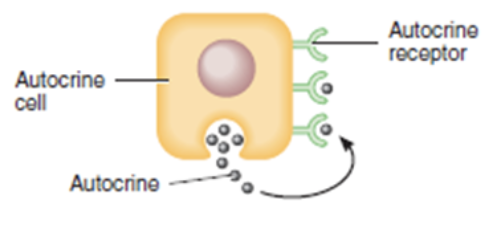
What is the hypothalamus and the pituitary gland?
-Hypothalamus is region of brain that regulates numerous physiological functions and is the main link between endocrine and nervous system
-Sends nerve signals to brain areas and also synthesises and releases hormones by the involvement of pituitary gland
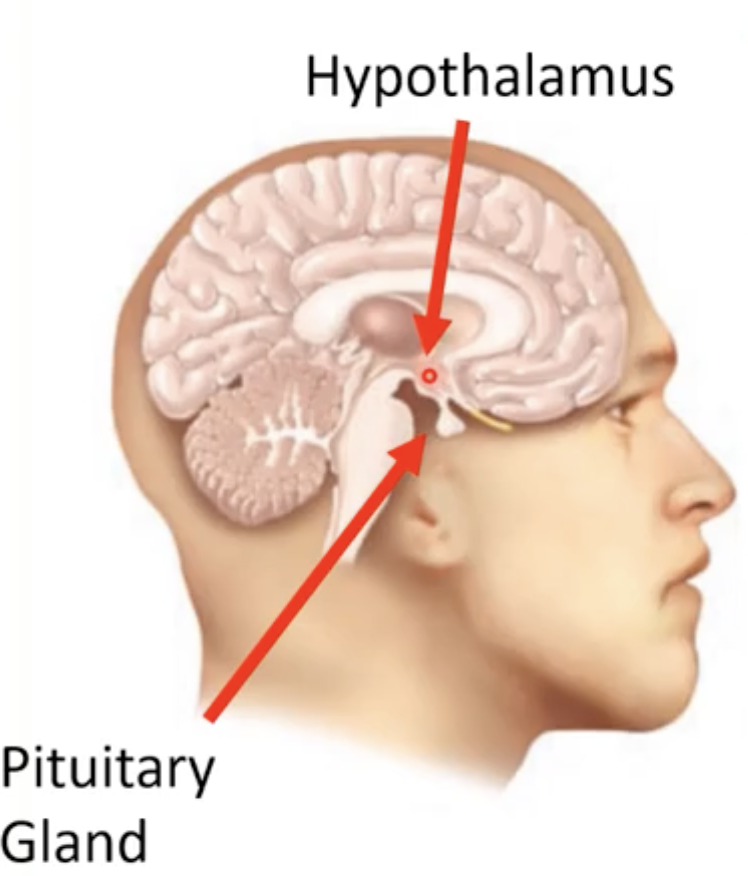
What is the organisation of the pituitary gland?
-It is encased by sphenoid bone and consists of 2 anatomically and functionally separates portions in the adult
Anterior pituitary components:
-Pars distalis: hormone producing
-Pars tuberalis: Sheath from pars distalis and winds around infundiblium
Posterior piutuitary components:
-Pars nervosa: Releases hormones
-Infundibulum: Neural axons with thier terminals in the pars nervosa
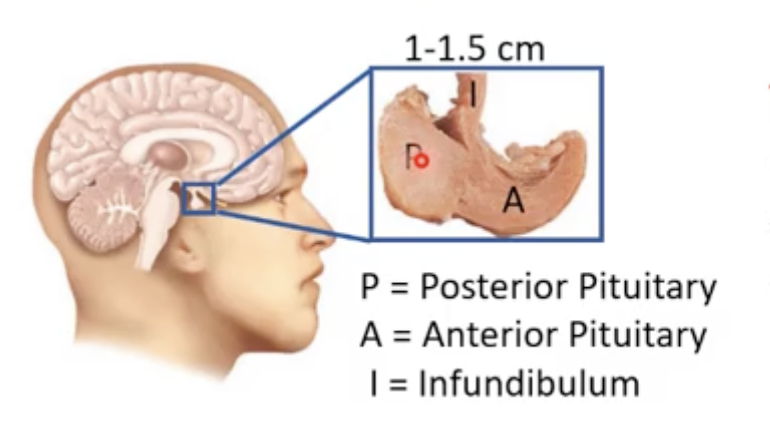
What is the role of the hypothalamus-Posterior pituitary gland?
-The posterior pituitary does not synthesise hormones, instead they are synthesised by cell bodies in the hypothalamus
What is the organisation of the anterior pituitary gland?
1.Somatotrophs: Secrete human growth hormone
2.Thyrotrphs: Secrete thyroid stimulating hormone
3.Gonadotrophs: Secrete gonadotropins-Leutinizing hormone and follicle stimulating hormone
4.Lactotrophs: Secrete prolactin
5.Corticotrophs: Secrete adrenocorticotropic hormone

What is the role of the hypothalamus anterior pituitary?
The hypothalamus makes special hormones and releases them into tiny blood vessels (the hypophyseal portal system).
-First, they go into the primary capillary plexus at the base of the brain.
-Then, they travel down the portal veins to reach the anterior pituitary.
In the anterior pituitary, these hormones control whether pituitary cells release or stop releasing their own hormones.
-The pituitary hormones are then released into the secondary capillary plexus, enter the blood, and travel all around the body to act on different organs.
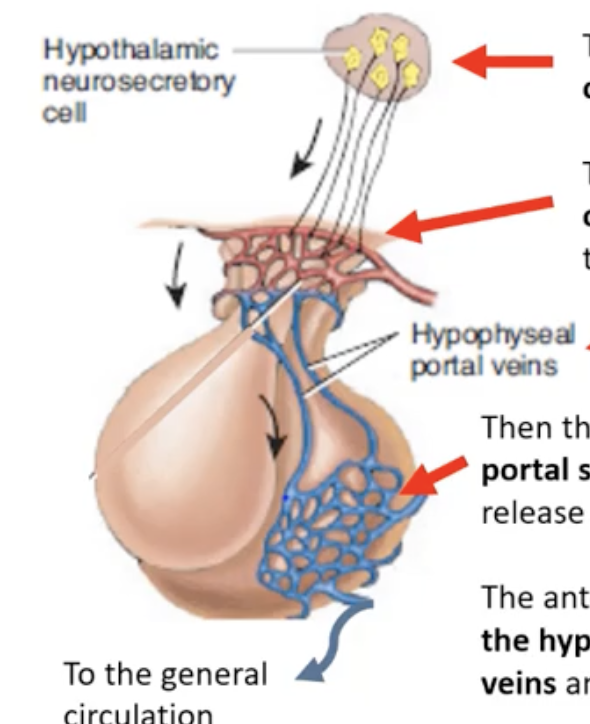
What hormones are released by neurosecretory cells in the hypothalamus?
Growth Hormone Releasing Hormone (GHRH) - induces the release of growth hormone from somatotrophs.
Somatostatin - This hormone acts on somatotrophs to inhibit release of growth hormone.
Thyroid releasing hormone (TRH) - induces the release of thyroid stimulating hormone from thyrotrophs.
Gonadotropin releasing hormone (GnRH) - acts on gonadotrophs to release follicle stimulating hormone or leutinising hormone.
Prolactin releasing hormone - chemical identity is not yet clarified, acts on lactotrophs to increase prolactin release.
Dopamine - inhibits prolactin release from lactotrophs.
Corticotropin releasing hormone (CRH) - acts on corticotrophs to increase release of adrenocoticotropin hormone (ACTH).
What are the functions of oxytocin/
During birth, stretching of the cervix triggers the brain to release oxytocin.
Oxytocin makes the uterus contract more strongly, pushing the baby further, which causes even more oxytocin release (positive feedback) until the baby is born.
After birth, oxytocin helps the breasts release milk for feeding.
What are the functions of antidiuretic hormone?
-Acts on the kidneys to reduce urination, on sweat glands to reduce water loss and its a powerful vasoconstrictor
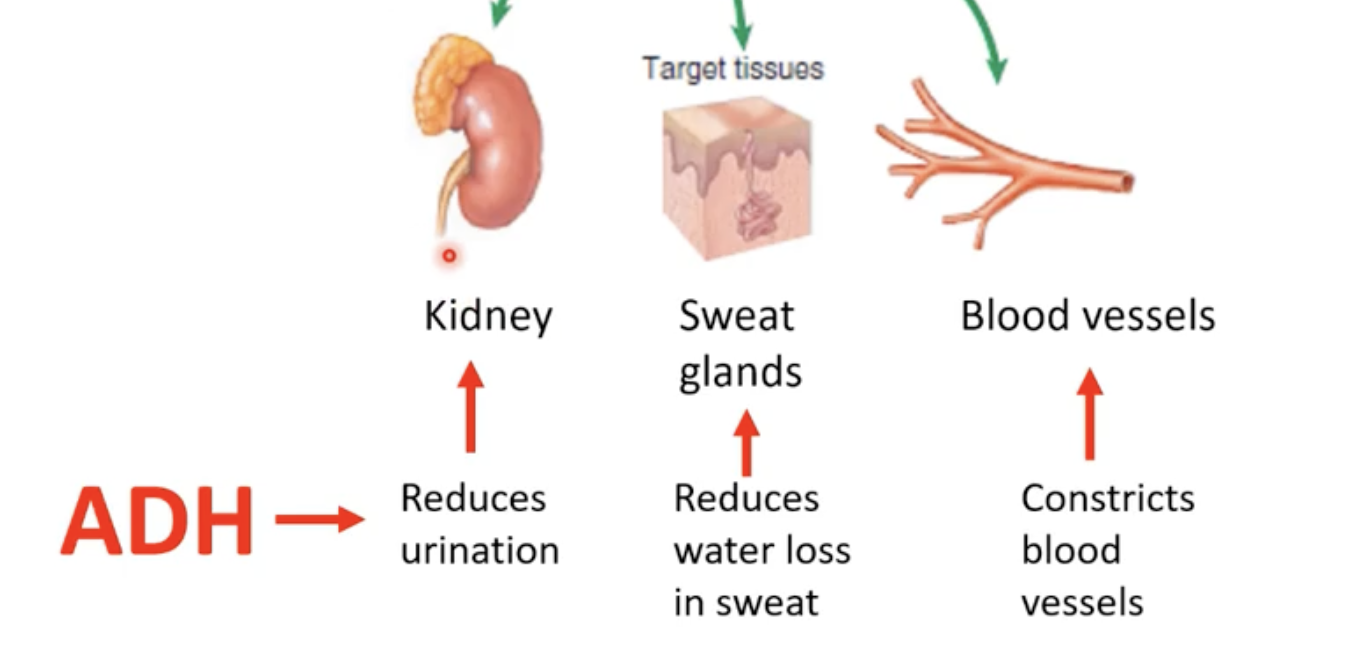
What is the regulation of antidiuretic hormone release?
Osmoreceptors sense how concentrated the blood is.
If solute concentration is high, they trigger more ADH (antidiuretic hormone) release.
If solute concentration is low, they reduce ADH release.
Other factors like blood pressure, blood volume, and stress also influence ADH levels.
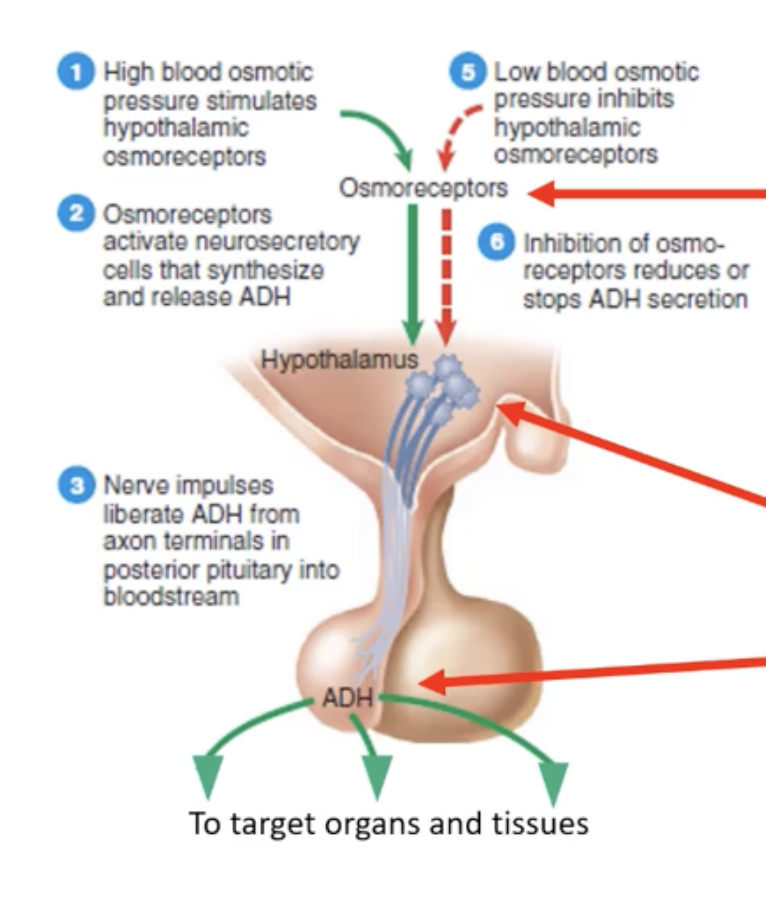
What hormones are relased from the posterior pituitary?
-Oxytocin (oxy) and Antidiuretic hormone (ADH)
-They are released into the capillary plexus of the posterior pituitary and reach the systematic circulation via the posterior hypophyseal veins
What are the different cells and hormones of the anterior pituitary gland?
Somatotrophs → release Growth Hormone (GH) → makes liver produce IGFs → GH + IGFs stimulate bone, cartilage, and soft tissue growth + increase protein synthesis + cell division. In the liver, GH also increases glucose production.
Thyrotrophs → release TSH → stimulates the thyroid gland → more thyroid hormones.
Gonadotrophs → release LH & FSH:
LH:
Females → causes ovulation, corpus luteum formation, and release of oestrogen & progesterone.
Males → increases testosterone production.
FSH:
Females → helps egg development + oestrogen release.
Males → stimulates sperm production.
Lactotrophs → release Prolactin (PRL) → stimulates milk production.
Corticotrophs → release ACTH → acts on adrenal cortex → makes it release glucocorticoids (e.g., cortisol).
How does the regulation of the release of hormones of the anterior pituitary gland happen?
The hypothalamus makes releasing hormones (neurohormones).
These act on the anterior pituitary, which then releases another hormone (Hormone X).
Hormone X acts on a target endocrine gland, causing it to release its hormone (Hormone Y).
Negative feedback keeps the system in balance:
Hormone X can inhibit the hypothalamus.
Hormone Y can inhibit both the hypothalamus and the anterior pituitary, reducing further release.
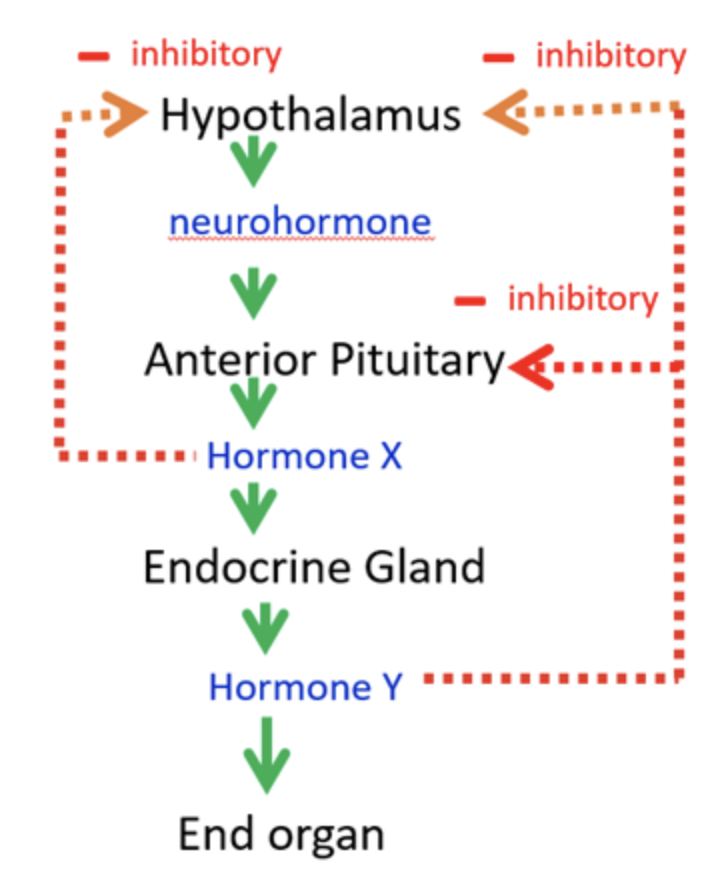
How does the growth hormone release get regulated?
The hypothalamus releases:
GHRH → stimulates GH release from somatotrophs.
Somatostatin → inhibits GH release.
The anterior pituitary releases GH.
GH acts on the liver → liver releases IGFs.
Negative feedback loops:
GH & IGFs → inhibit GHRH release from hypothalamus.
GH & IGFs → stimulate somatostatin release (further blocking GH).
IGFs → also directly inhibit GH release from the anterior pituitary.
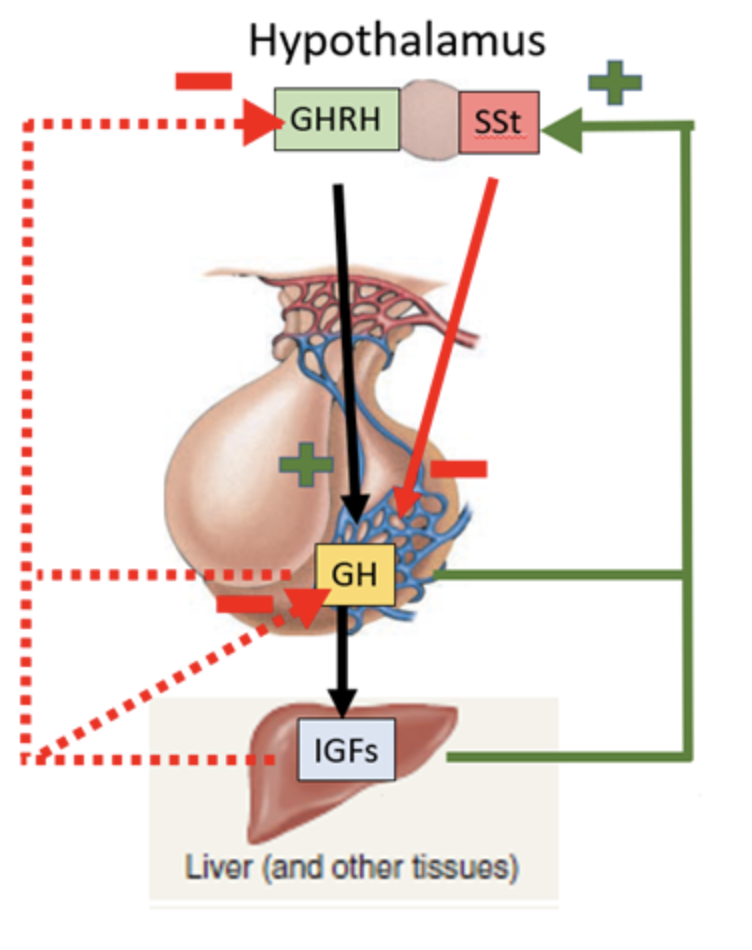
What other regulators can influence growth hormone release?
Sleep:
Deep sleep → GH increases (surge).
REM/light sleep → GH decreases.
Other influences:
Stress & exercise → increase GH.
High glucose & high free fatty acids (FFA) → decrease GH.
Low glucose & low FFA → increase GH.
What are the effects of growth hormone?
GH acts on liver, muscle, and other tissues → stimulates release of IGFs.
GH + IGFs together → increase protein synthesis and cell division → growth of bone & soft tissues.
IGFs (not GH) → specifically promote cartilage growth.
In the liver, GH also increases glucose production.
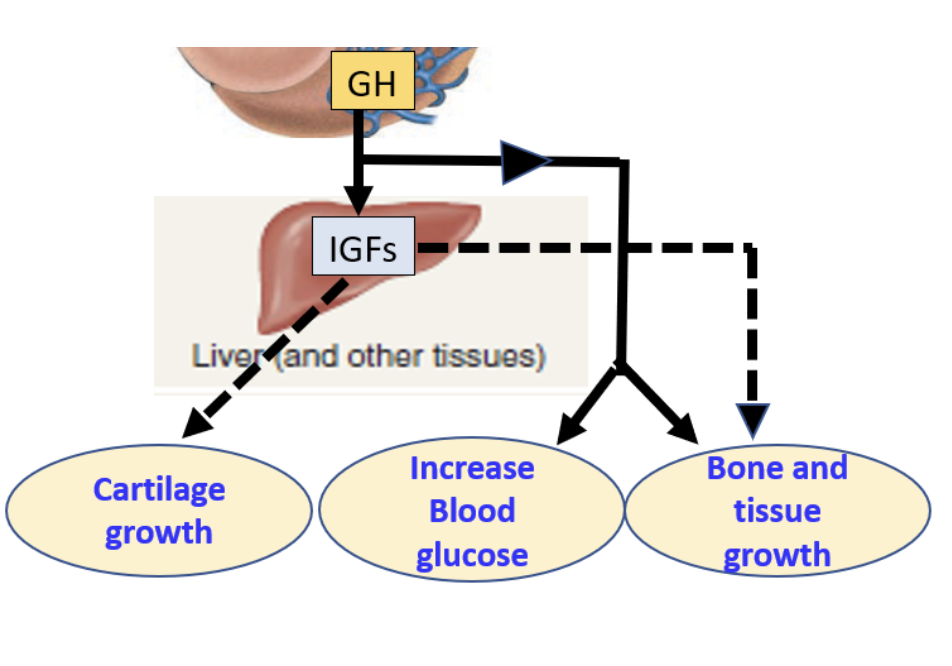
What are the consequences of growth hormone deficiency?
Condition: GH deficiency → dwarfism.
Features: Head, trunk, and limbs are small but proportionate.
Causes:
Genetic factors.
Pituitary gland damage → low GH production.
Treatment: Early use of recombinant human GH therapy.
What are the consequences of excess growth hormone?
Childhood (before growth plates close) → Gigantism
Extremely tall stature (proportional growth).
Very rare (~3 cases per million).
Cause: usually pituitary tumour.
Adulthood (after growth plates close) → Acromegaly
Enlarged jaw, hands, feet, and coarsened facial features.
Cause: usually pituitary tumour.